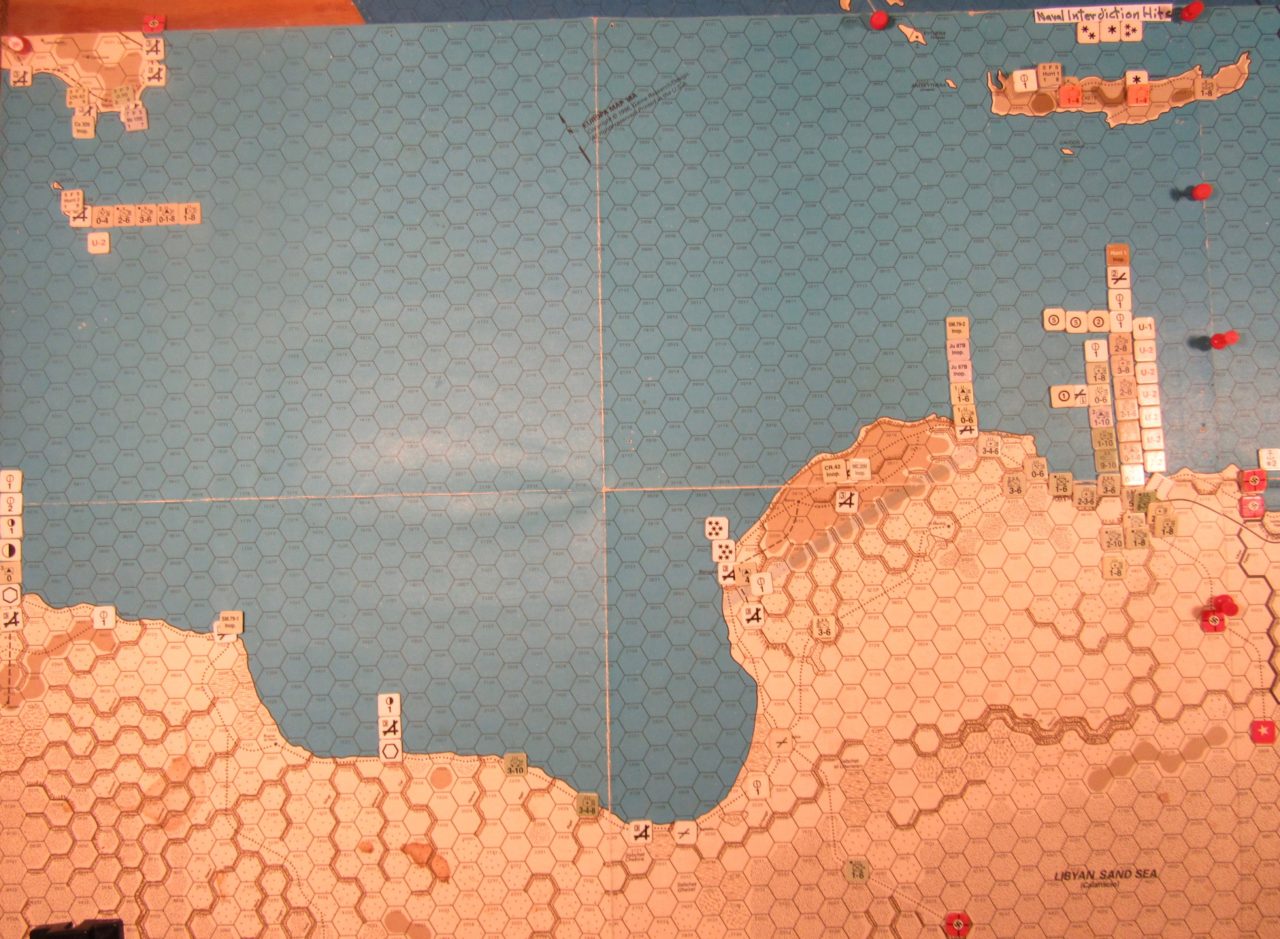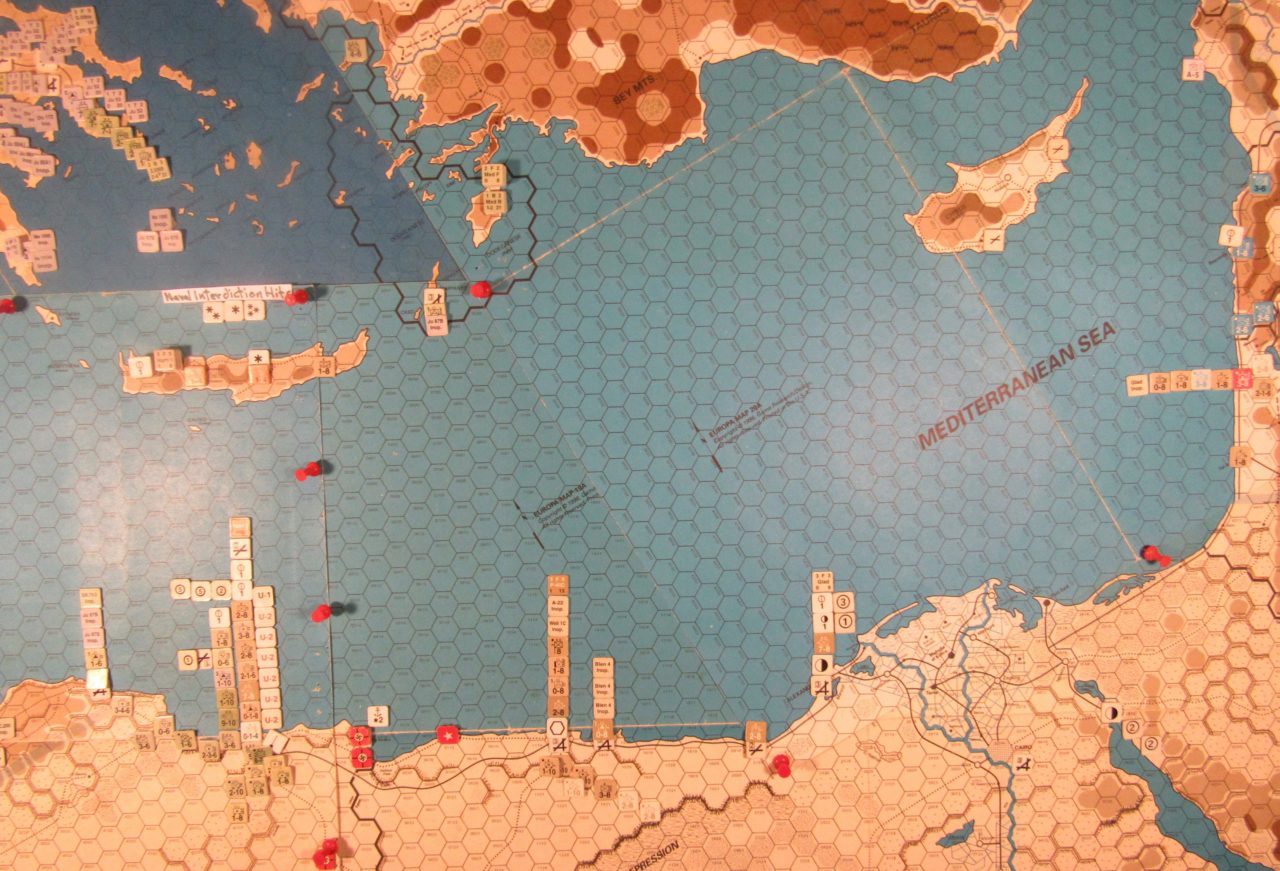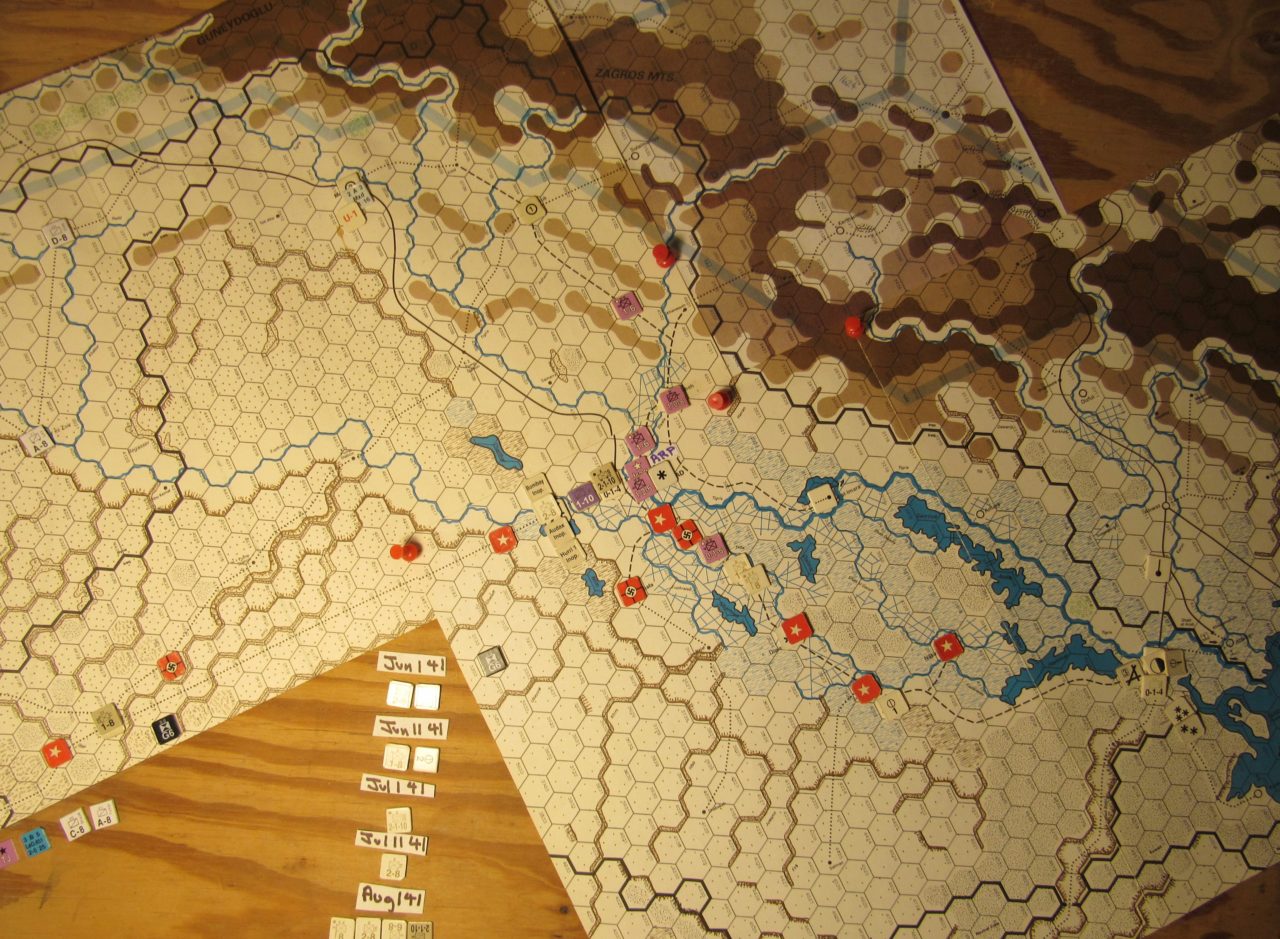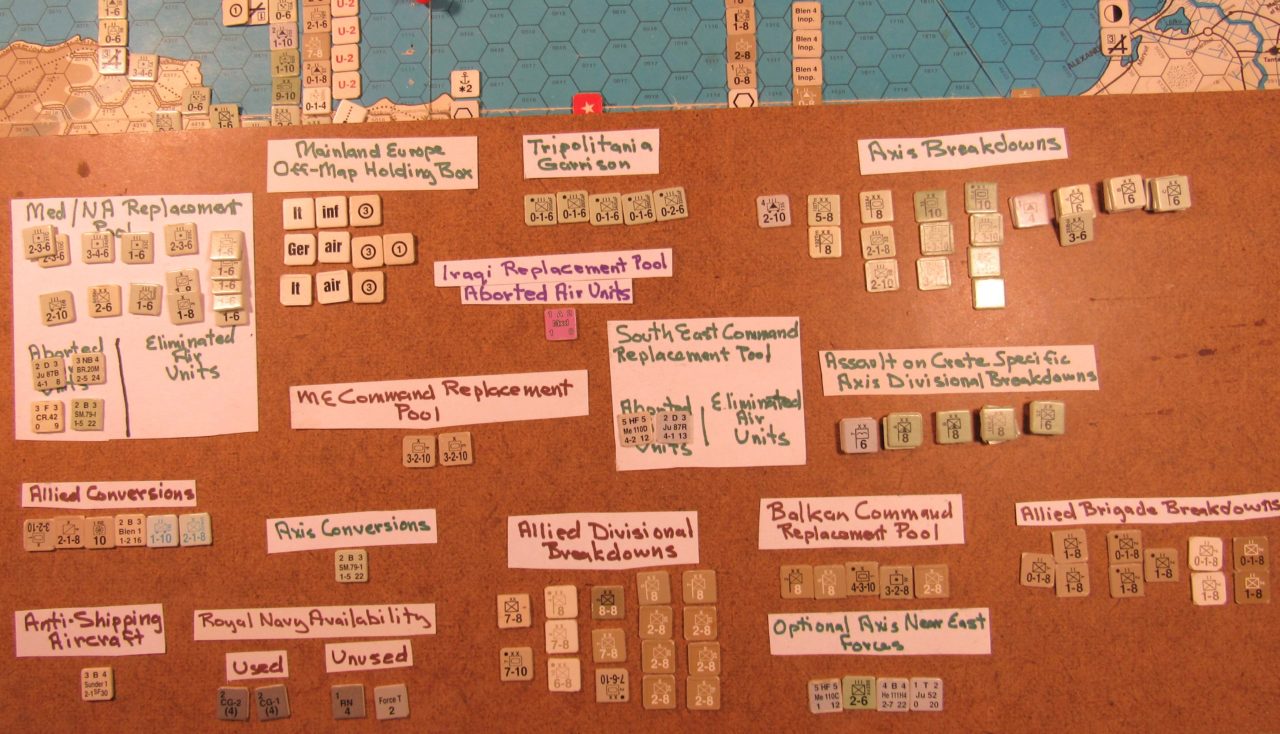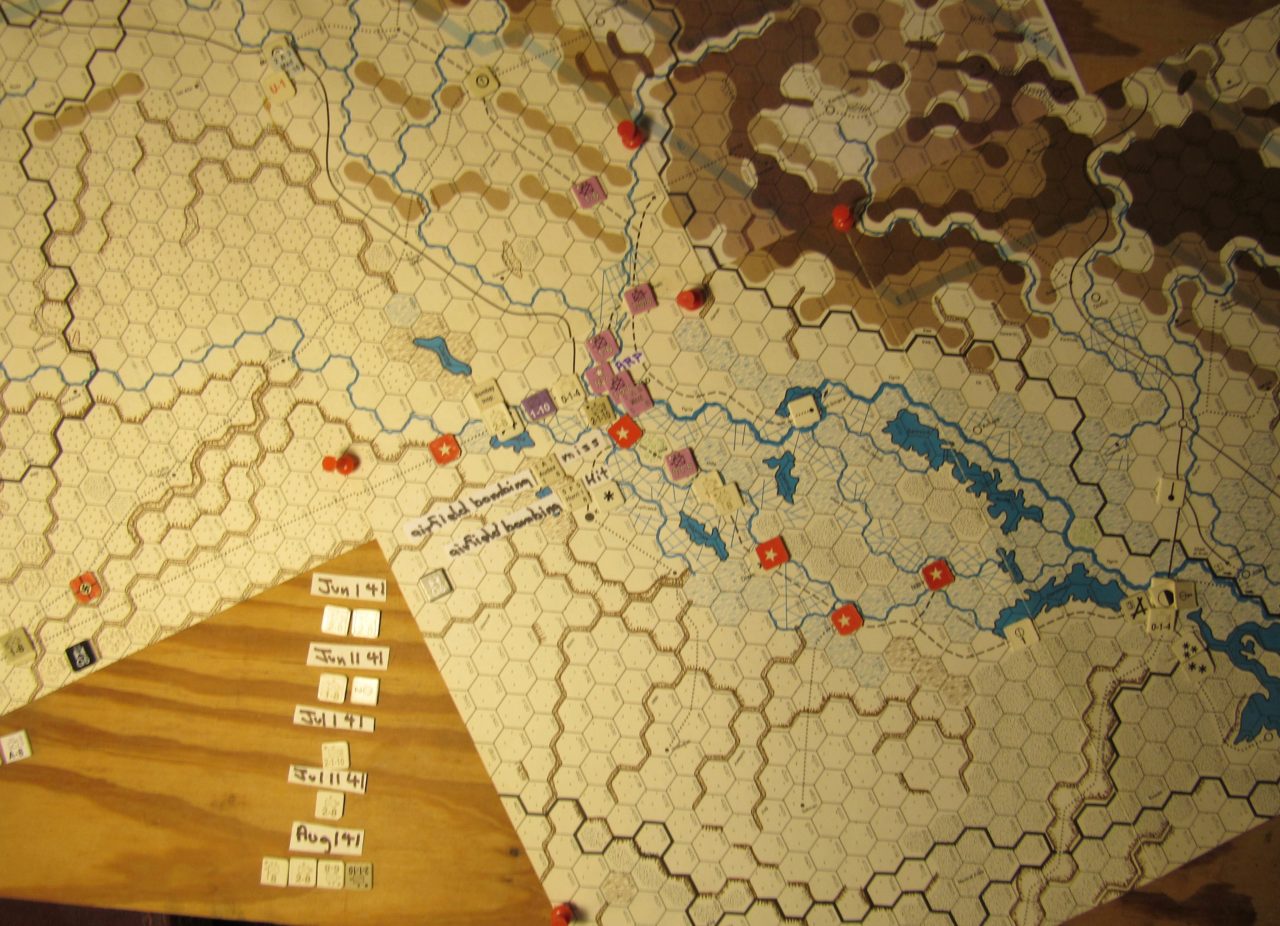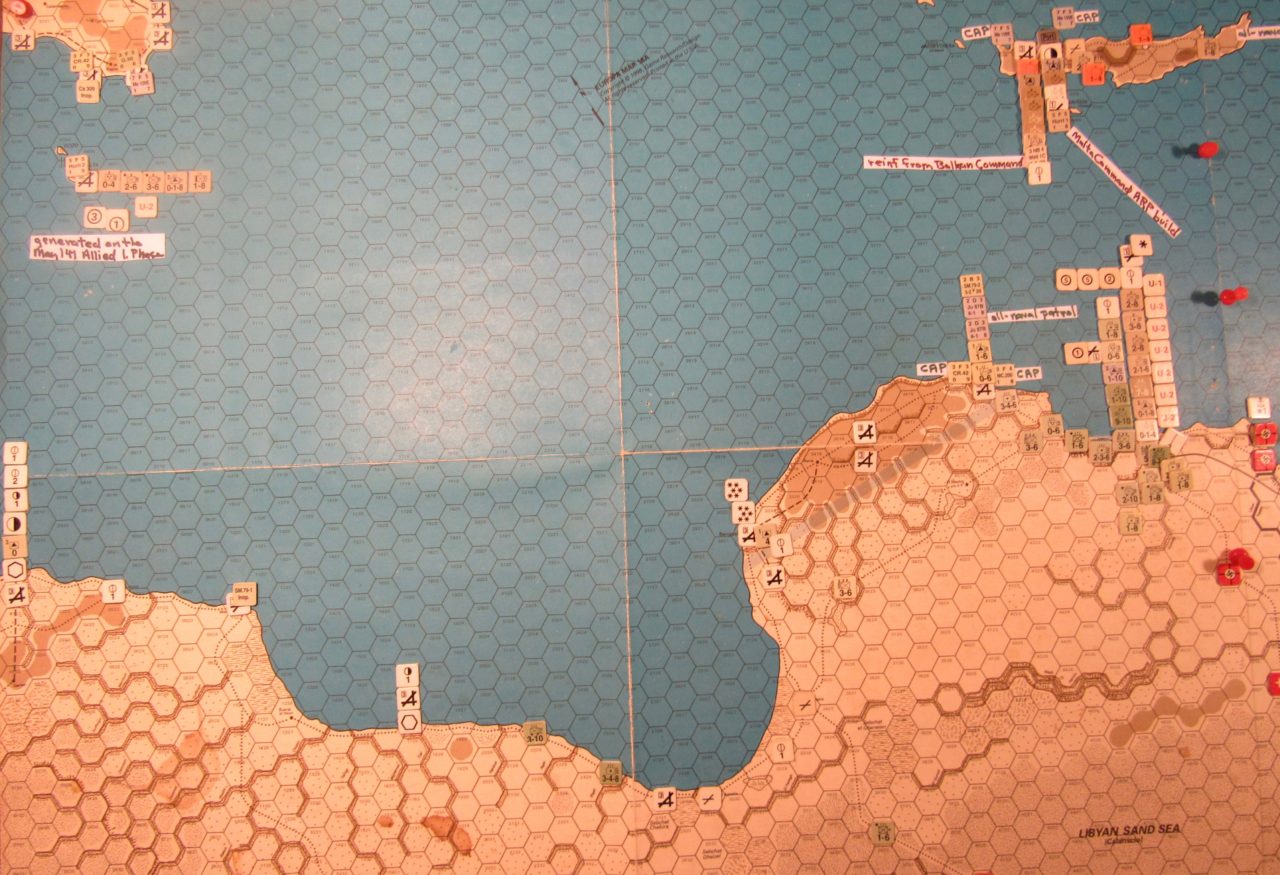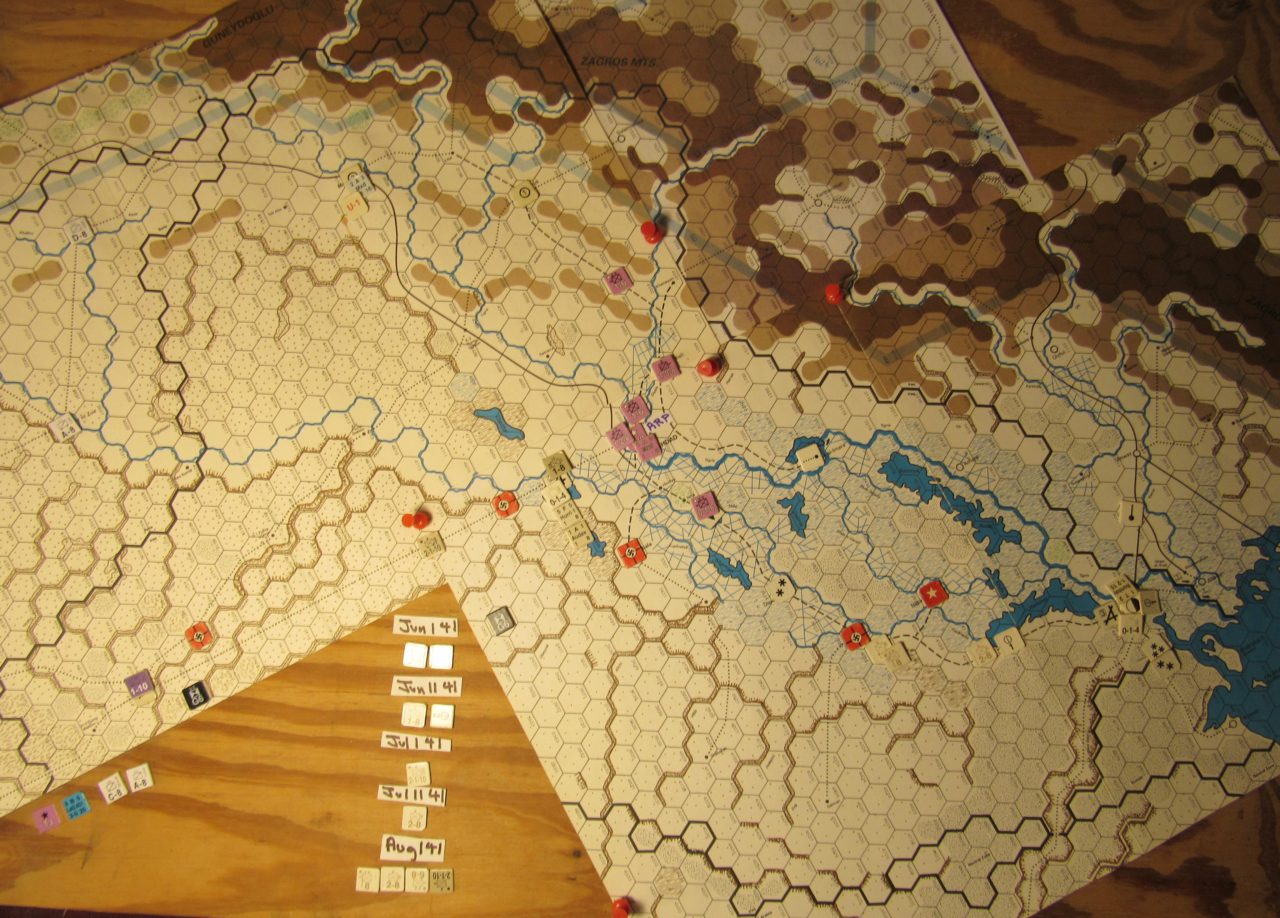Malta [end of turn]
Valletta (18A:0407):
3-cap permanent airfield
Malta Status: 9, end of turn [at start 10, – 1 repair this turn = 9 at the end of the I. Phase and Allied turn]
Malta Repair Rate: 1 repair point each turn.
Valletta hex flak factor: 5 (3 intrinsic + 2 for 0-1-8 Hv AA II 10).
3-6* Inf X 1 M
2-6* Inf X 2 M
1-8 MG II 2 Ch
0-1-8 Hv AA II AA=2 10
0-4 Cons X MC
Hurri 2 5F5 1/9 [a Malta Command step 14 of the I. Phase ARP build from the Aborted Air Units Box in the Malta Command Replacement Pool]
Note: In the naval movement step of the M. Phase the W Med NTP carrying the 4 gsp’s generated at Gibraltar is sunk upon entering map 18A by Axis Central Med anti-shipping forces. The Allied player decides not to then hazard an E Med NTP carrying gsp’s available at Alexandria or Suez to Malta. The implications of this (eg., no ready gsp’s at the Valletta hex) in the upcoming May II 41 Axis Initial Phase, at step 11, is that the ground units on Malta will be then definitely Red U-2, but not technically “isolated,” per WW Rule 12C1b-Limited Supply Terminals, Rule 12E2b-2nd and Subsequent Turns out of General Supply, and Optional Rule 12E3-Elimination from Lack of General Supply, and thereby certainly not liable for elimination. In the EA reported game we are not using WW Optional Rule 12E4-Intrinsic AA and General Supply Effects. However, regardless of the availability or not of gsp’s, next turn the Hurri 2 F type air unit at the Valletta hex definitely will be in general supply, per Rule 23I3-Allied Malta Special Air Unit Supply. Interestingly, it appears implicit at WW Rule 37I3-Malta Repair, that being out of general supply does not affect the British 0-4 Cons X MC unit’s ability to enable the spending of the Allied OB Malta repair points at step 19 of the Initial Phase.
In Libya [end of turn]
Tobruch (18A:4817) [clear terrain improved fortress/standard port coast hex]:
improved fortress
Construction on the fortress improvement is complete this I. Phase; this construction began in the Apr II 41 I. Phase.
2-cap temporary airfield; the cons III repairs the 1 hit of airfield damage and increases the temporary airfield capacity to 2.
0-1-4 Cons X 66 RPC (Col) [never moved; in the M. Phase it sends 4 MPs in the hex to repair the airfield hit and increase the airfield capacity to 2; technically becomes Red U-2 at step 11 in the I. Phase]
0-1-8 Hv AA II 51 [never moved; technically becomes Red U-2 at step 11 in the I. Phase]
7-8 Inf XX 9 (Aus) [never moved; technically becomes Red U-2 at step 11 in the I. Phase]
2-8 Inf X 16 [never moved; technically becomes Red U-2 at step 11 in the I. Phase]
2-1-6 Tnk II 7 RT [never moved; technically becomes Red U-2 at step 11 in the I. Phase]
3-8 Art X 13 [never moved; technically becomes Red U-2 at step 11 in the I. Phase]
2-8 Inf X 23 [never moved; technically remains Black U-1 at step 11 in the I. Phase]
Hurri 1 5F5 1/8 SAAF [inop.; began turn at Matruh; air transferred to here late in the E. Phase; in general supply in I. Phase]
one step of attack supply [never moved]
one step of attack supply [began turn at Matruh; sea transported to here, using 3 E Med NTPs]
12 gsp’s
- These gsp’s were broken down in the May I 41 Axis I. Phase (at step 16) from a step of attack supply present in the hex. This provides general supply to the forces in the Tobruch hex in the May II 41 Allied and the May II 41 Axis Initial Phases.
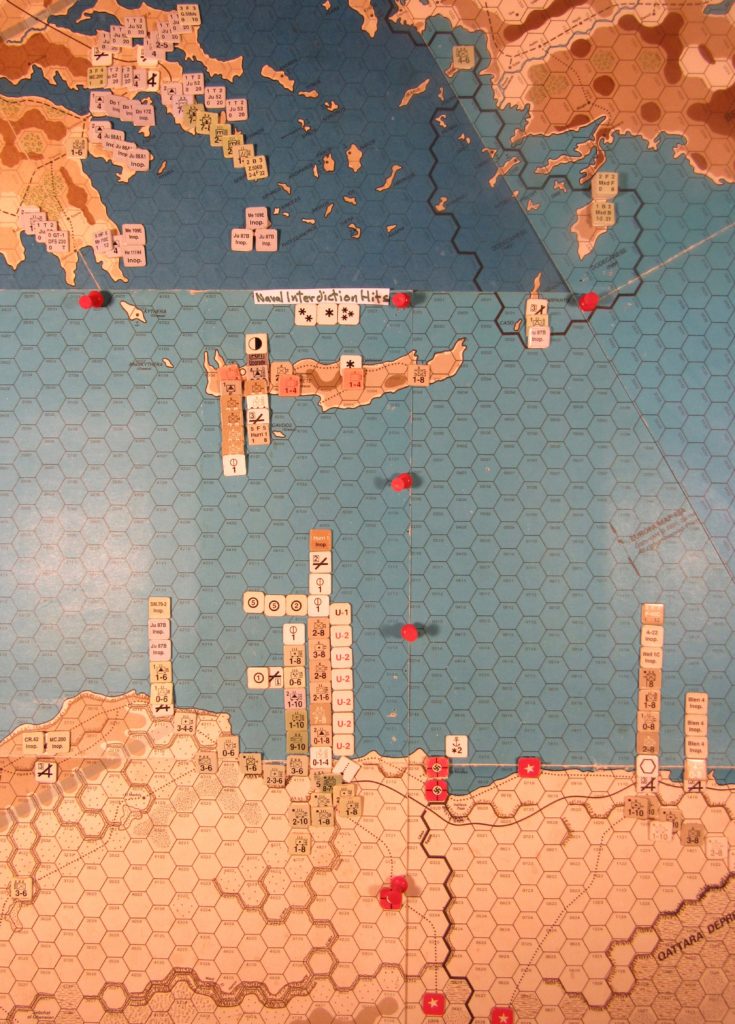
May II 41 Allied EOT dispositions: eastern Libya, western Egypt, mainland Greece, Crete, and the Aegean
In Egypt [end of turn]
Matruh (19A:1218) [clear terrain point city/minor port road/major rail line junction coast hex]:
railhead marker
3-cap permanent airfield
fort marker (construction complete this initial phase)
8 Inf XX HQ 6 [never moved]
2-8 Inf X 5 (SA) [began turn at Alexandria; admin moved to here]
1-8 MG II 1 RNF [began turn at Suez; railed to here]
0-8 Lt AA II 57 [began turn at Khania, on Crete; at the beginning of the M. Phase air transported to here by the Well 1C NB type air unit, at night]
Well 1C 3NB4 1-6/28 [inop. Per the 1941 ME/ER-II/Crete Scenario draft OB this unit, previously in the Greece off-map holding box, at the beginning of the Allied turn is placed “at any airbase/airfield on Crete or the Egyptian or Palestinian coastlines.” In the EA demonstration game it begins the turn on Crete, at Khania (18A:4403/15B:2114). Early in the M. Phase it performs a night air transport air mission to Matruh of the 0-8 Lt AA II 51, also beginning the turn at Khania]
P-40C 5F5 1/13 SAAF [operative; never moved]
A-22 3A3 2-1/19 [inop.; began turn here; in the middle of the E. Phase it did a tac port bombing air mission at Porto Bardiya; Miss; returned to base here]
19A:1219 [clear terrain Siwa road hex, S of Matruh]:
3-2-10 Arm X 7 [began turn at 19A:1019; moved to here]
1-10* Mot SG X AA=1 2 [began turn at 19A:1018; moved to here]
19A:1320 [clear terrain hex]:
1-2-10* Mot SG X AA=1 7 [began turn at 19A:1019; moved to here]
1-10* Mot Inf X 3 (Ind) [began turn at 19A:1018; moved to here]
19A:1420 [clear terrain hex]:
3-8 Inf X 22 G [began turn at 19A:1219; moved to here]
19A:1418 [clear terrain major rail coast road hex, two hexes E of Matruh]:
3-cap permanent airfield
0-8 Hv AA II AA=1 2 (Aus) [began turn at Port Said; railed to here]
Blen 4 3B3 1-2/23 [inop.; began turn here; in the middle of the E. Phase it did a strat port bombing air mission at Porto Bardiya; Miss; returned to base here]
Blen 4 3B3 1-2/23 [inop.; began turn here; on the previous May I 41 Axis turn it did a non-phasing air transfer to here from Habbaniya; in the middle of the E. Phase it did a strat port bombing air mission at Porto Bardiya; Miss; returned to base here]
Blen 4 3B3 1-2/23 [inop. Per the 1941 ME/ER-II/Crete Scenario draft OB this unit, previously in the Greece off-map holding box, at the beginning of the Allied turn is placed “at any airbase/airfield on Crete or the Egyptian or Palestinian coastlines.” In the EA demonstration game it begins the turn here. In the middle of the E. Phase it did a strat port bombing air mission at Porto Bardiya; scores a Hit; returned to base here.]
19A:1521 [clear terrain hex]:
2-8* Inf X 5 (Ind) [began turn at 19A:1321; moved to here]
19A:1621 [clear terrain hex; adjacent to Qattara Depression]:
2-8* Inf X 11 (Ind) [began turn at 19A:1522; moved to here]
El Alamein 19A:2119/20A:5033 [clear terrain point city major rail coast road hex]:
2-cap temporary airfield
2-8 Eng X 1 (Aus) [began turn at Matruh, where in the I. Phase it completed the construction of the fort in the hex; in the M. Phase it railed to El Alamein and spent the remaining 6 MPs there building the 2-cap temporary airfield]
Alexandria (20A4930/19A:2416) [major port/full city hex/major rail coast hex]:
Supply Terminal marker
3-cap permanent airfield
7-8 Inf XX 7 (Aus) [XX reassembled here at the end of the M. Phase after the supported components railed into Alexandria]
- 2-8* Inf X 18 (Aus) [began turn at 19A:1219; spent 1 MP moving one hex to the major rail line coast hex, then railed to Alexandria]
- 2-8* Inf X 21(Aus) [began turn at 19A:1120; spent 2 MPs moving two hexes to Matruh, then railed to Alexandria]
- 2-8* Inf X 25 (Aus) [began turn at 19A:1220; spent 3 MPs moving two hexes to Matruh, then railed to Alexandria]
Glad 3F3 0/8 [operative; never moved]
1 resource point [never moved]
one step of attack supply [began turn at Matruh; never moved]
4 gsp’s generated in the May II 41 Allied Initial Phase [never moved]
Cairo (19A:3320) [clear terrain partial city hex]:
3-cap permanent airfield
Suez (19A:3718) [clear terrain dot city/major port major rail terminus coast hex]:
Supply Terminal marker
4 gsp’s generated in the May II 41 Allied Initial Phase [never moved]
In Palestine [end of turn]
Tel Aviv (20A:4710) [clear terrain dot city/minor port major rail line junction coast hex]:
1-8 Cav X 6 [never moved]
Haifa (20A:4710) [clear terrain dot city/major port transportation line junction coast hex]:
railhead marker
3-8* Mtn X Karp (Pol) [never moved]
1-8 Cav X 5 [never moved]
3-8* Inf X 1 FL (FF) [began at Gaza, after its conversion at step 14 of the I. Phase, per the WitD Allied OB; moved to here in the M. Phase]
1-8 AT II 65 [began turn at 19A:1418; railed to here]
0-8 Marine Cmdo II ME [began turn at Ismailia; admin moved to here]
Glad 3F3 0/8 [inop.; began turn at Ismailia; air transferred to here in the E. Phase]
Nazareth (20A:4809) [clear terrain point city secondary rail hex; SE of Haifia]:
2-1-6 Tnk II 4 RT [began turn at 19A:1018; admin moved along road to Matruh and then railed to here]
20A:4709 [rough terrain hex; NE of Haifa]:
2-8* Inf X 7 (Ind) [began turn at 19A:1421; regular moved to the major rail line coast hex, railed and then regular moved to here]
Middle East Command Replacement Pool [end of turn]
3-2-10 Arm X 3 [eliminated in combat on the Mar II 41 Axis turn C. Phase]
3-2-10 Arm X 4 [at-start in the ME Replacement Pool, per ER-II]
Greece Off-Map Holding Box
- At the end of step 14 of the I. Phase this box, which is a corollary of the previous Greece Command, is vacant and is a relic no longer in use by the Allied player. Perhaps technically speaking, the only item remaining in the Greece off-map holding box at the start of the May II 41 Allied turn was the second ME Command ARP that was transferred to there on the previous May I 41 Allied I. Phase. At step 14 of the current Allied I. Phase this ARP was expended to repair the Hurri 1 air unit beginning the turn in the Aborted Air Units Box in the now current Balkan Command Replacement Pool. “Mainland Greece” is Axis controlled at the beginning of the May II 41 game turn.
Special Assault on Crete Segment May II 41 Allied turn Allied Set-up
Allied Balkan Command
Crete [end of turn]
- Except as indicated, all Allied forces listed below on Crete are per the May II 41 Allied Initial Forces of the WW Assault on Crete Scenario Allied OB, found in the WW OB booklet, p. 7. They are placed on the map at at the Start of the game turn.
- The Greek government has evacuated. The 1941 ME/ER-II/Crete Scenario follows the WitD Allied OB Jun II 41 Allied turn Other Allies stipulations regarding the placement of the Greek and Yugoslav units in the Forming box of the ME Command holding box.
- At the beginning of the Allied turn there are no accumulated replacement points (RPs) in the Balkan Command. The Allies have a remaining Aegean NTP capacity of 1 NTP.
- The set-up below is the one done for the EA game reports. The 1941 ME/ER-II/Crete Scenario draft OB provisions for the May II 41 Allied turn Assault on Crete segment set-up for the Allies are essentially the same as indicated in the Assault on Crete Scenario Allied OB found in the WW OB booklet, on p. 7. Note the OB requirements for the positioning of the three Greek static Xs, which is “one unit in each standard port [hex] on the island of Crete.” These three Greek static Xs remain in their Crete standard port hexes throughout the May II 41 Allied turn, and are there in these same three Crete standard port hexes at the beginning of the May II 41 Axis turn. They may move as they like after the Axis player does a Special Operation (WW Rule 33) on Crete, or on the Jul I 41 turn, whichever comes first. They may certainly do an Enemy Reaction movement (WW Rule 33B) or Advance or Retreat after combat. The 0-2-0 Hv AA X NMBDO (RM) must remain in the Suda Bay hex 15B:2113, as it cannot move or be sea transported out. If eliminated, it is placed in the Replacement Pool in its original 0-2-6 side.
- [Standard] Supply Terminal: {Suda Bay} (18A:4503/15B:2113). For details, see Rule 12C1c-Allied Logistics Bases: per the Port Upgrade marker Suda Bay is now a major port; the British Royal Marine hv AA X there is flipped to its 0-2-0 Hv AA X side, and the Suda Bay hex is now an Allied standard Supply Terminal.
- At step 13 of the current Allied I. Phase the Allied player declares the existence of a South Aegean Naval [Tight] Interdiction Zone, per WW Rule 31D7. This tight naval interdiction zone “is [then] in effect until the start of his next initial phase.”
Khania (18A:4403/15B:2114) [rough terrain reference city/standard port road terminus coast hex]:
- The 3-cap permanent airfield beginning the turn at Khania is destroyed by Allied ground units in the M. Phase and is then removed from the map. The Khania reference city airbase remains intact at the end of the Allied turn.
1-4 Static X Khania (Greek) [never moved; per the Scenario rules must remain in the hex the May II 41 Allied turn]
2-8 Inf X 4 (NZ) [never moved]
2-8 Inf X 6 (NZ) [never moved]
2-8 Inf X 19 (Aus) [never moved]
2-8 Inf X 16 (Aus) [never moved]
5 pos flk AA=1 [British; never moved]
one step of attack supply [never moved]
{Suda Bay} 18A:4503/15B:2113 [rough terrain coast road hex; now a major port]:
Port Upgrade marker
- This makes the hex a major port.
Supply Terminal marker
3-cap temporary airfield [Per the 1941 ME/ER-II/Crete Scenario draft OB, a 1-cap temporary airfield marker may be placed at the Suda Bay hex at the beginning of the I. Phase, at the Allied player’s option, if the 0-1-4 Cons X 43 RPC (Col) is also placed here at the beginning of the the I. Phase. In the M. Phase the cons X spends its 4 MPs in the hex to increase the cap to 3.]
0-1-4 Cons X 43 RPC (Col) [never moved]
3-8 Inf X 5 (NZ) [never moved]
0-2-0 Hv AA X AA=4 MNBDO 1 [never moved]
Hurri 1 5F5 1/8 [operative; an I. Phase step 14 ARP build from the BC Replacement Pool; never moved]
Rethymnon (18A:4603/15B:2212) [rough terrain point city/standard port coast road hex]:
- In the M. Phase the 1 cap-permanent air strip beginning the turn at Rethymnon is destroyed by the Greek static X in and is removed from the map.
1-4 Static X Reth (Greek) [never moved; per the Scenario rules must remain in the hex the May II 41 Allied turn]
2-8 Inf X 14 [never moved]
Erakleion (18A:4903/15B:2310) [rough terrain reference city/standard port coast road hex]:
- The Erakleion reference city airbase is destroyed by the Greek static X in the M. Phase and a damage hit marker is placed in the hex.
1-4 Static X Erak (Greek) [never moved; per the Scenario rules must remain in the hex the May II 41 Allied turn]
Hagios Nikolaos (19A:0203/15B:2508) [rough terrain point city/minor port coast road terminus hex]:
1-8 Marine Cmdo X Layf [never moved; In the WW Assault on Crete Scenario Allied draft OB this unit is a Jun I 41 Allied turn reinf, coming from the Middle East Holding Box. In the new Scenario it is placed “anywhere on Crete” at the beginning of the May II 41 Allied Turn. This is to be sure the Allied player doesn’t always conveniently “save” it for use later in the Scenario, in the ME or NE Commands]
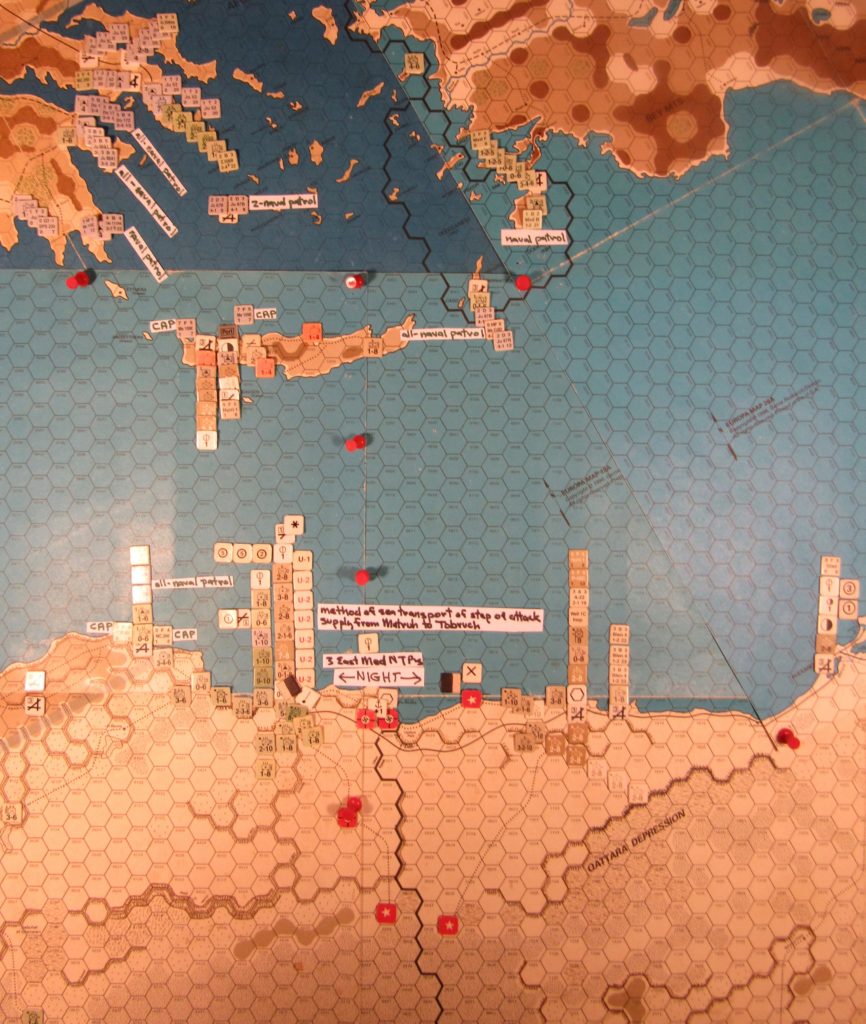
May II 41 Allied Movement Phase: sea transport of the step of attack supply into Tobruch, from Martuh
Balkan Command Replacement Pool [at-start/end of turn]:
4-3-10* Arm X 1 [After the voluntary Axis cessation of operations in the Balkans (WW Rule 3E5b), when the Allied player “moves all non-Greek/Yugoslav Allied forces in the BC … to the … ME Command” Replacement Pool, this special supported arm X conversion unit is removed from play and is replaced by the original pre-conversion 3-2-10 Arm X 1.]
3-2-8 Art X W [This is a fragile unit in the new Scenario and cannot be replaced once eliminated in Greece. As such, it will not be moved from the BC to the ME Replacement Pool when the Axis ceases operations in the Balkans.]
2-8 Inf X 17 (Aus)
8 Inf XX HQ 2 (NZ)
8 Inf XX HQ 6 (Aus)
In pro-Axis Coup Iraq [end of turn]:
Rutbah (21A:5023) [stony desert point city road junction hex]:
1-cap permanent airstrip
1-8 Inf II 11 (CS) [began turn at Habbaniya; admin moved 16 hexes to here along Iraq desert road]
Habbaniya (22A:2828) [clear terrain point city road hex]:
3-cap permanent airfield
2-8 Inf X 21 (Ind) [began turn at 22A:4218; in the M. Phase it regular moved back to Basra; from there it was air transported in the M. Phase to Habbaniya by the Bombay T type air unit]
Audax 1A1 1/8 [inop.; began turn here; did airfield bombing air mission at the Baghdad airbase at the end of the M. Phase; Miss; returned to base here]
Bombay 1T2 1-2/15 [inop.; began turn at Basra; in the M. Phase air it air transported the 2-8 Inf X 21 (Ind) to here]
Hurri 1 5F5 1/8 [inop.; began turn here; did airfield bombing mission at the Baghdad airbase at the end of the M. Phase; scores a Hit; returned to base here]
22A:2826 [clear terrain road/major rail line junction hex; W of Baghdad]:
2-1-10* Mot Inf X Hab [began turn at 22A:2833; in M. Phase it regular moved to 22A:2926, on the way capturing Hindiya (22A:3025); in E. Phase it exploited to 2826. This apparently sets up the optimum Variable Iraqi Coup Collapse dice roll situation to be done in the upcoming May II 41 Axis I. Phase]
0-1-4 Static II 1 AS (Col) [began turn at Habbaniya; regular moved here]
22A:2827 [canal intensive road hex; E of Habbaniya]:
1-10 Mot Cav III AL [Arab Legion] (T-J) [began turn at Rutbah; admin moved to here]
Shaibah (22A:4314) [clear terrain point city secondary rail line hex]:
3-cap permanent airfield
Basra (22A:4313) [clear terrain dot city/major port transportation line junction hex, w/ a major river hexside; end of turn]:
Allied Supply Terminal marker
0-1-4 Static II 2 As (Col) [never moved]
one step of attack supply [never moved]
22A:4021 [clear terrain secondary rail line hex]:
one step of attack supply [began turn at 22A:4417; spent 5 SMP’s moving to here in the E. Phase]
22A:3324 [canal intensive secondary rail line hex]:
8* Inf XX HQ 10 (Ind) [began turn at 22A:4021; regular moved along secondary rail line to here]
1-8 Inf X 20 (Ind) [began turn at 22A:4021; regular moved along secondary rail line to here]
Special Assault on Crete Segment May II 41 Allied turn Axis Set-up
- All German forces listed below on map 15B or on the island of Scarpanto on map 19A come from the May II 41 Axis Initial Forces of the WW Assault on Crete Scenario found in the WW OB booklet, on p. 21. Most of the Italian forces in the special Assault on Crete segment are new additions per the 1941 ME/ER-II/Crete Scenario draft OB. They come from the WW Marita-Merkur (M-M) Scenario Axis OB. It was recalled that these Italian units sometimes came into play at Crete during the relevant Axis assault on Crete game turns in some WW Desert and the Balkans Scenarios played here in the past. The Axis forces are placed on the map at the Start of the Allied May II 41 turn. The “released” Italian Rhodes garrison forces come into play per the WW Assault on Crete Scenario.
- The Axis player has a Southeast Command Special Operation (airborne and/or amphibious) “planned in advance” per WW Rule 33-Special Operations. Although technically he is supposed to do this planning at step 8 of the prior Axis Initial Phase, in the EA game reporting this is declared at the start of the May II 41 Allied turn, when the special Assault on Crete segment of the new Scenario begins.
- The Axis Aegean NTP availability is 7. There are no initial accumulated Ger or It Southeast (SE) Command ARPs or RPs in the special Assault on Crete segment of the new Scenario. But note that at step 14 in the Initial Phase the Axis player can transfer Med/NA Command ARPs stored at the mainland Europe off-map holding box to the SE Command, per WW Rule 25C14-ARP Transfer, and use them the same turn.
- Per WW Rule 41C5-Assault on Crete [Scenario], at b.-Special Conditions, the Axis initial temporary airfields on BF map 15B remain in play even if no construction units are present in their hexes.
- In the 1941 ME/ER-II/Crete Scenario draft OB, the arrival of the WitD Axis OB Jun I 41 Axis turn German “Available In Europe” LW air unit reinforcements (including the Me 110D Return air unit) is contingent on the Axis cessation of operations in the Balkans, per Rule 3E5b-Voluntary Cessation of Operations in the Balkans. In other words, in the new Scenario, these important German LW Med/NA Command reinforcements “Return” (at step 14 of the I.Phase) to the Med/NA Command in the same Axis Initial Phase that the Axis ceases operations in the Balkans (at step 4 of the I. Phase). For the new Scenario, this evidently coincides with the stipulations found in the WW Desert and the Balkans Scenario “Return of Luftwaffe Air Units from [the] Balkans”, found in the WW OB booklet, on p. 24. Per both the WW Desert and the Balkans Scenario and the 1941 ME/ER-II/Crete Scenario these “Return of [the] LW air units from the Balkans” always arrive ready, converted, and available, regardless of any eliminations or aborts incurred while operating in the SE Command.
- Special Assault on Crete segment SE Command Reinforcements are available per the Axis Reinforcements of the WW Assault on Crete Scenario Axis OB, at p. 21. In addition, in the 1941 ME/ER-II/Crete Scenario draft OB, a step of attack supply is available at Athenai at step 14 of the May II 41 Axis Initial Phase. This is considered here to be one of the same steps of attack supply listed as German reinforcements for the Apr I and the Apr II 41 Axis turns of the WW Marita Scenario Axis OB. If necessary, a second step of attack supply should also be available at Athenai for the Merkur operation on the Jun I 41 axis turn; and at least one more should be available at Athenai on the Jun II 41 Axis Initial Phase, if needed that turn.
- There may be some new Scenario-specific minor tweaking of the “conditions” provisions of Rule 3E5b-Voluntary Cessation of operations in the Balkans. More later.
Axis Southeast (SE) Command [at-start/end of turn]:
On Samos:
Samos (20A:1432/15B:1400) [rough terrain point city minor port coast hex]:
4-6 Inf XX 6 Cno [per WW Axis Assault on Crete Scenario]
On Rodi:
Rodi (20A:2230): [clear terrain point city standard port island coast hex]
3-cap-permanent airfield
3-4-6 Inf XX 50 Reg [released Rhodes garrison]
1-2-5 Art X 35 [released Rhodes garrison]
1-2-5 Art X 36 [released Rhodes garrison]
1-0-6 Lt Tnk II 312 [released Rhodes garrison]
0-6 Lt AA II AA=1 Rodi [released Rhodes garrison]
Mxd F 2F2 0/8 [operative; released Rhodes garrison; never moved]
20A:2331: [rough terrain island coast hex]
3-cap permanent airfield
1-6 Hv AA III AA=2 Rodi [released Rhodes garrison]
Mxd B 1B2 1-2/21 [operative.; released Rhodes garrison; assigned to Naval Patrol air mission; never flew the mission]
On Scarpanto:
Scarpanto (19A:0701): [rough terrain point city minor port island coast hex]
3-cap permanent airfield
0-1-6 Lt AA II AA=1 Scar [released Rhodes garrison]
Ju 87B 2D3 4-1/8 (Ger LW) [inop.; began turn here; assigned Naval Patrol air mission; flew Naval Interdiction early in E. Phase; returned to base here]
{Me 110D 5HF5 4-2/12 (Ger LW)} [Aborted; began turn here; assigned Naval Patrol air mission; flew Naval Interdiction early in E. Phase; Aborted by Allied naval flack; placed in SE Command Aborted Air Units Box]
{Ju 87R 2D3 4-1/13 (Ger LW)} [Aborted; began turn here; assigned Naval Patrol air mission; flew Naval Interdiction early in E. Phase; Aborted by Allied naval flack; placed in SE Command Aborted Air Units Box]
On Melos:
Melos (15B:1610) [clear terrain point city minor port Aegean islet hex]:
3-cap permanent airfield [per the WW M-M and Assault on Crete Scenarios]
Me 109E 7F5 1/7 (Ger LW) [inop.; began turn here; in I. Phase flew CAP air mission over the Suda Bay hex; at end of E. Phase returned to base here]
Ju 87B 2D3 4-1/8 (Ger LW) [inop.; began turn here; assigned Naval Patrol air mission; flew Naval Interdiction early in the E. Phase; returned to base here]
Ju 87B 2D3 4-1/8 (Ger LW) [inop; began turn here; assigned Naval Patrol air mission; flew Naval Interdiction early in the E. Phase; returned to base here]
Mainland Greece:
15B:1415 [southeastern Peloponnese rough terrain coastline hex]:
3-cap temporary airfield [per WW Assault on Crete Scenario]
5 pos flk AA=1 (Ger LW) [Axis Assault on Crete unit]
Me 109 E 7F5 1/7 (Ger LW) [inop.; began turn here; in I. Phase flew CAP air mission over the Khania hex; at end of E. Phase returned to base here]
Me 110C 5HF5 1/12 (Ger LW) [operative; began turn here; never moved]
He 111H 4B4 2-7/S/22 (Ger LW) [inop.; began turn here; assigned Naval Patrol air mission; flew Naval Interdiction early in the E. Phase; returned to base here]
Kalamai (15B:1118) [clear terrain reference city standard port secondary rail terminus southern Peloponnese coast hex]:
1-5 Glider II 1 St (Ger LW) [Axis Assault on Crete unit]
2 x 5 pos flk AA=2 (Ger LW) [Axis Assault on Crete unit]
Ju 52 1T2 0/20 (Ger LW) [operative; began turn here; never moved]
DFS 230 0GT-1 -/T (Ger LW) [operative; began turn here; never moved]
15B:0914 [rough terrain eastern Peloponnese coast hex; E of Nauplion, SE of Korinthos]:
3-cap temporary airfield [per WW Assault on Crete Scenario]
2 x 5 pos flk AA=2 (Ger LW) [Axis Assault on Crete unit]
Ju 88A1 3B5 3-5/26 (Ger LW) [inop.; began turn here; assigned Naval Patrol air mission; flew Naval Interdiction early in the E. Phase; returned to base here]
Ju 88A1 3B5 3-5/26 (Ger LW) [inop.; began turn here; assigned Naval Patrol air mission; flew Naval Interdiction early in the E. Phase; returned to base here]
Ju 88A1 3B5 3-5/26 (Ger LW) [inop; began turn here; assigned Naval Patrol air mission; flew Naval Interdiction early in the E. Phase; returned to base here]
Athenai (15B:0911) [great port/full hex city major rail terminus coast hex]:
7-6 Para XX 7 (Ger LW) [Axis Assault on Crete unit)
7-8 Mtn XX 5 (Ger) [Axis Assault on Crete unit]
7-8 Mtn XX 6 (Ger) [Axis Assault on Crete unit]
2-6 Eng III 685 (Ger) [Axis Assault on Crete unit; “any,” per the WW Assault on Crete Axis OB]
2-6 Eng III 690 (Ger) [Axis Assault on Crete unit; “any,” per the WW Assault on Crete Axis OB]
1-8 Ski II MC [This is an added Italian ground unit from the WW M-M Scenario that is included in the 1941 ME/ER-II/Crete Scenario draft OB.]
2 x 5 pos flk AA=2 (Ger LW) [Axis Assault on Crete unit]
3 x Ju 52 1T2 0/20 (Ger LW) [all operative; all began turn here; all never moved]
Z 506B 2B3 2-4/F/22 [operative; began turn here; never moved. This is an added Italian air unit from the M-M Scenario that is included in the 1941 ME/ER-II/Crete Scenario draft OB. Note that WW Optional Rules 23G1a & b are in use.]
15B:0813 [rough terrain secondary rail line coast hex; E of Korinthos]:
3-cap temporary airfield [per WW Assault on Crete Scenario]
5 pos flk AA=1 (Ger LW) [Axis Assault on Crete unit]
Do 17Z 3B4 3-4/13 (Ger LW) [inop.; began turn here; assigned Naval Patrol air mission; flew Naval Interdiction early in the E. Phase; returned to base here]
Do 17Z 3B4 3-4/13 (Get LW) [inop.; began turn here; assigned Naval Patrol air mission; flew Naval Interdiction early in the E. Phase; returned to base here]
Do 17Z 3B4 3-4/13 (Ger LW) [inop.; began turn here; assigned Naval Patrol air mission; flew Naval Interdiction early in the E. Phase; returned to based here]
15B:0711 [clear terrain major rail line coast hex; 2 hexes N of Athenai]:
3-cap temporary airfield [per WW Assault on Crete Scenario]
5 pos flk AA=1 (Ger LW) [Axis Assault on Crete unit]
Ju 52 1T2 0/20 (Ger LW) [operative; began turn here; never moved]
Ju 52 1T2 0/20 (Ger LW) [operative; began turn here; never moved]
G 50 bis 3F3 0/10 [operative; began turn here; never moved. This is an added Italian air unit from the M-M Scenario that is included in the 1941 ME/ER-II/Crete Scenario draft OB.]
15B:0811 [clear terrain secondary rail line coast hex, NW of Athenai]:
3-cap permanent airfield [per WW Assault on Crete Scenario]
2-5 Para III 1 St (Ger LW) [Axis Assault on Crete unit]
5 pos flk AA=1 (Ger LW) [Axis Assault on Crete unit]
MC 200 3F4 1/8 [operative; began turn here; never moved. This is an added Italian air unit from the M-M Scenario that is included in the 1941 ME/ER-II/Crete Scenario draft OB.]
Ju 52 1T2 0/20 (Ger LW) [operative; began turn here; never moved]
Ju 52 1T2 0/20 (Ger LW) [operative; began turn here; never moved]
Levadia (15B:0612) [clear terrain point city major rail line hex]:
3-cap temporary airfield [per WW Assault on Crete Scenario]
3 x Ju 52 1T2 0/20 (Ger LW) [all operative; all began turn here; all never moved]
Naupulion (15B:0915) [clear terrain point city standard port secondary rail line coast hex]:
1-6 Marine Cmdo II Gr/SM [This is an added Italian ground unit from the M-M Scenario that is included in the 1941 ME/ER-II/Crete Scenario draft OB.]
SE Command Replacement Pool [end of turn]
Aborted Air Units:
Me 110D 5HF5 4-2/12 (Ger LW) [aborted by Allied naval flack while performing Naval Interdiction Air Mission early in the E. Phase]
Ju 87R 2D3 4-1/13 (Ger LW) [aborted by Allied naval flack while performing Naval Interdiction Air Mission early in the E. Phase]
Turn Activity
In the Initial Phase, at step 16, the Allied player generates 4 new gsp’s at the Suez and Alexandria Allied Standard Supply sources.
In the Initial Phase, at step 22, the non-phasing Axis player flies the MC 200 and CR 42 F type air units based at the 3-cap permanent airfield at 18A:3617 on the CAP air mission over the Derna hex (18A:4116). In the I. Phase the Me 109E F type air unit based at the airfield at 15B:1415, on the Peloponnese coastline in Greece, flies the CAP air mission over Khania (18A:4403/15B:2114), on Crete. In the I. Phase the Me 109E F type air unit based at the airfield at the Aegean isle of Melos (15B:1610) flies the CAP air mission over Suda Bay (18A:4503/15B:2113) , on Crete. The Hurri 1 F type air unit based at Khania declines to intercept either Axis CAP air mission.
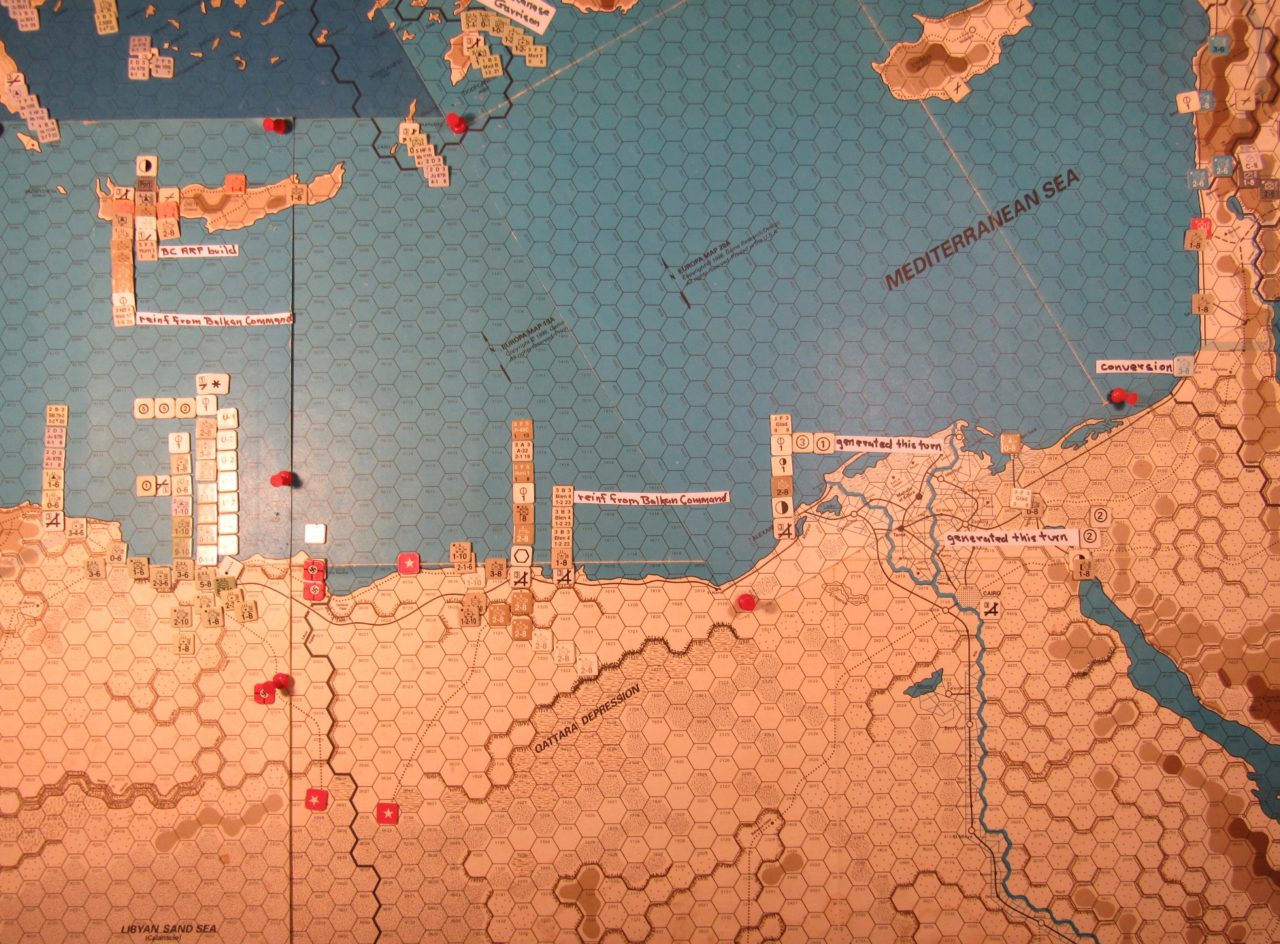
May II 41 Allied end of step 21 of the Initial Phase: eastern Libya, Egypt, Pasestine, Crete, Scarpanto, and Rodi
In the Initial Phase, at step 24, the 4 old gsp’s at at the Valletta hex (18A:0407), on Malta that were generated on the May I 41 Allied Initial Phase are removed from the map. The four old gsp’s at the Suez hex (19A:3718) that were generated on the May I 41 Allied Initial Phase are removed from the map.
Early in the Movement Phase the Well 1C NB type air unit based at Khania, on Crete, does an air transport air mission to Matruh at night, air transporting to there the 0-8 Lt AA II 51.
In the naval movement step at the start of the Movement Phase the Allied player successfully sea transports to Tobruch the step of attack supply beginning the turn at Matruh, using 3 E Med NTPs. However, the W Med NTP is sunk by Axis anti-shipping forces (WW Rule 31E) attempting to sea transport the 4 gsp’s from Gibraltar to Malta. With so many Axis air units in the Central Mediterranean region on the naval patrol air mission, the Allied player decides not to risk Allied E Med NTPs naval transporting available gsp’s from either Alexandria or Suez to Malta in the naval movement step.
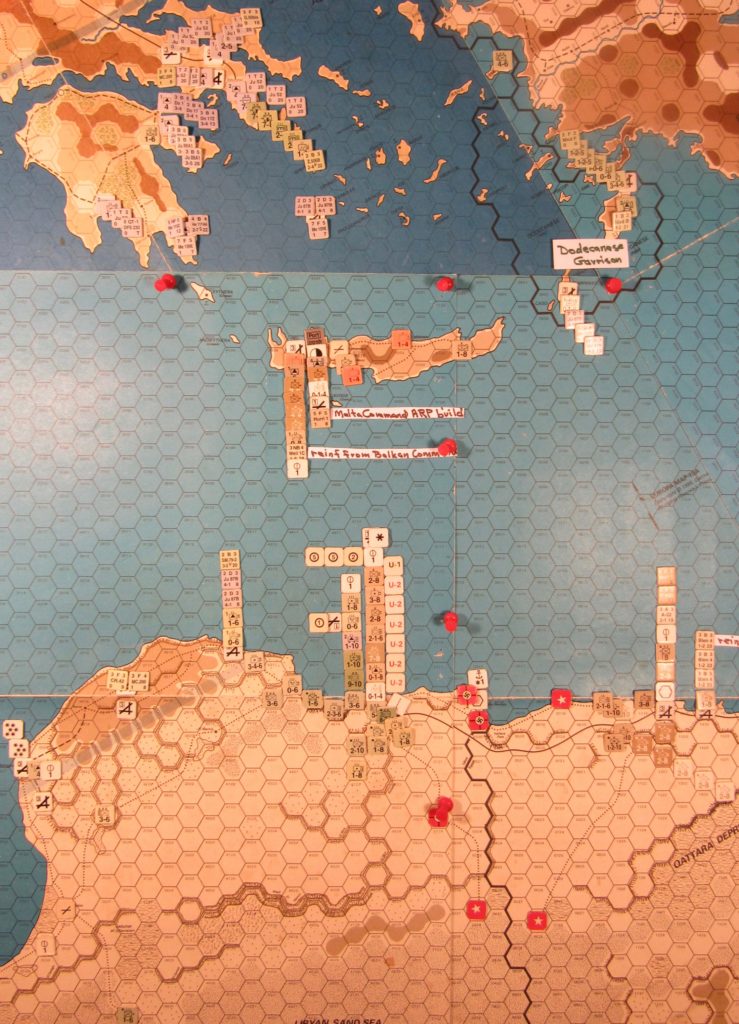
May II 41 Allied end of step 21 of the Initial Phase dispositions: easten Libya, western Egypt, mainland Greece, Crete, Melos, and the Dodecanese
The following Allied ground units are railed in the Mid East rail net:
2-1-6 Tnk II 4 RT
2-8* Inf X 7 (Ind)
1-8 AT II 65
2-8* Inf X 25 (Aus)
2-8* Inf X 21 (Aus)
2-8* Inf X 18 (Aus)
2-8 Eng X 1 (Aus)
0-8 Hv AA II AA=1 2 (Aus)
1-8 MG II 1 RNF.
In the M. Phase the Bombay T type air unit based at Basra, in Iraq, air transports the 2-8 Inf X 21 (Ind) to the Habbaniya airfield hex. In the M. Phase the Ind inf X had moved to the Basra hex. The Bombay air unit bases at the Habbaniya airfield.
Late in the M. Phase the Br Audax A type and the Hurri 1 F type (on the bombing air mission) air units both fly the airfield bombing air mission to the Iraqi Coup Baghdad hex. The Hurri 1 air unit scores a hit on the airfield, which also aborts the Iraqi Mxd A type air unit based there. It is placed in the Aborted Air Units Box of the Iraq Replacement Pool. The two Br air units return to base to the Habbaniya airfield.
Early in the Allied E. Phase the non-phasing Axis player flies a large array of Naval Interdiction air missions (WW Rule 20G2i) to all-sea target hexes inside the “tight” South Aegean naval interdiction zone surrounding Crete (WW Rule 31D7). The Hurri 1 F type air unit at Khania declines to intercept any of the Naval Interdiction air missions in its intercept range. The following are the specifics of these Naval Interdiction air missions, per the sequence flown:
- From the 3-cap temporary airfield at 15B:0813: three Ger LW Do 17Z 3B4 3-4/13 air units; they fly 12 hexes to the Target Hex at 18A:4502/15B:2012; Contact Attempt modifiers: +3 for calm sea conditions -2 for the 12 hex range = +1 modifier; Success Table die roll is a 3, +1 for the modifier = 4: a Failure. All three air units return to their base.
- From the 3-cap temporary airfield at 15B:0914: three Ger LW Ju 88A1 3B5 3-5/26 air units; they fly 11 hexes to the Target Hex at 18A:4402/15B:2013; Contact Attempt modifiers: +3 for calm sea conditions -2 for the 12 hex range = +1 modifier; Success Table die roll is a 4, +1 for the modifier = 5: a Success; then three 5 factor Allied naval flack shots: all Misses; then 9 bombing die rolls, looking for 6’s only: 1 Hit! All three air units return to their base.
- From the 3-cap permanent airfield on the Aegean isle of Melos (15B:1610): two Ger LW Ju 87B 2D3 4-1/8 air units; they fly 5 hexes to the Target Hex at 18A:4702/15B:2111; Contact Attempt modifiers: +3 for calm sea conditions -0 for the 5 hex range = +3 modifier; Success Table die roll is a 4, +3 for the modifier =7: a Success; then two 5 factor Allied naval flack shots: both Returns (two “6’s”). The two Ju87B air units return to base at Melos.
- From the 3-cap temporary airfield at 15B:1415: one Ger LW He 111H 4B4 2-7/S/22; it flies 5 hexes to the Target Hex at 18A:4203/15B:2215; Contact Attempt modifier: +3 for calm sea conditions -0 for the 5 hex range = +3 modifier; Success Table die roll is a 2, +3 for the modifier = 5: a Success; then one 5 factor Allied naval flack shot: a Miss; then two bombing die rolls, looking for 5’s or 6’s, w/ the +1 roll modifier for the air unit being a S Code type: 2 Hits! The air unit returns to its base.
- From the 3-cap permanent airfield on Scarpanto, at hex 18B:0701/15B:2503: one Ger LW ME 110D 5HF5 4-1/8 air unit (on a bombing air mission), one Ger LW Ju 87R 2D3 4-1/13 air unit, and one Ger LW Ju 87B 2D3 4-1/8 air unit; they fly 2 hexes to the Target Hex at 19A: 0502/15B:2505; Contact Attempt modifiers: +3 for calm sea conditions -0 for the 2 hex range = +3 modifier; Success Table die roll is a 3, +3 for the modifier = 6: Success; then three 5 factor Allied naval flack shots: the Me 110D and the Ju 87R air units are Aborted, but the Ju 87B air unit makes it through the flack; then 4 bombing die rolls, looking for 5’s or 6’s, w/ the +1 roll modifier for the Ju 87B being a D type air unit: 3 Hits! The surviving air unit returns to its base.
- From the 3-cap permanent airfield at the Derna hex (18A:4116), in Libya: two Ger LW Ju 87B 2D3 4-1/8 air units and one It SM 79-2 2B3 3-4/V/20 air unit; they fly 12 hexes to the Target Hex at 18A:4405/15B:2315, the two Ger Ju 87B air units flying the air mission at extended range; Contact Attempt modifiers: +3 for the calm sea conditions -2 for the 12 hex range = +1 modifier; Success Table die roll is a 3, +1 for the modifier = 4: a Failure. The three Axis air units return to their base.
Thus the Axis reap a total of 6 VP’s for their large Naval Interdiction air mission to the seas surrounding Crete.

May II 41 Allied end of Initial Phase dispositions: eastern Libya, Egypt, Palestine, mainland Greece, Crete, and the Dodecanese
Next in the E. Phase the A-22 A type air unit based at Matruh and the three Blen 4 B type air units based at the airfield at 19A:1418 do the port bombing air mission to the Porto Bardiya hex (19A:0318). One Hit is achieved; afterwards all the Allied air units return to their respective airbases.
Then late in the E. Phase the Hurr 1 (SAAF) F type air unit based at Matruh does the air transfer air mission to Tobruch. The Glad F type air unit based at Ismailia does the air transfer mission to Haifa, in Palestine.
At the end of the turn the Allies have the following accumulated replacements: 8.5 Br inf, 2 Br arm, 2.5 Aus, and 2.5 NZ RPs. All items are stored at Alexandria. There are no available Allied ARPs at the end of the I. Phase/Allied turn.
Commentary
For the Allied player this turn appears to be all about maneuver, conservation, and preparation. At Tobruch, the besieging Axis army, strengthened by Rommel’s Afrika Korps, grips the Allied citadel with a bony hand; here the Allies face an uncertain future. Another vexing question is whether the Iraqi pro-Axis Coup will collapse on the next Axis turn’s critical Variable Iraqi Coup Collapse dice roll, now that the Allies have completed part of their concentric advance towards the environs of Baghdad. In the meantime, a motley and sketchy Allied attack force is collected at Palestine and Alexandria, in preparation for their hasty invasion of the admittedly neutral but definitely Axis-aiding and abetting Vichy Levant. Once the Allied invasion of the Vichy Levant begins, it will probably have to be reinforced turn by turn on an ad hoc basis. Finally, the masters of war compel Wavell to force at Crete a major diversionary battle with the Axis aggressors, and he bravely establishes there a “Creteforce” of Balkan intervention survivors to defend the beleaguered island, come what may. In managing all the above the Western Desert Force is stripped to the minimum, and even backs up a couple of hexes eastwards to the newly constructed Matruh fort bastion. But in some manner of the term, the unfolding saga of the battle for Crete puts a brake on the apparent Axis drives in both the Western Desert and in the Near East. In the occult shadow of the unknown looming Barbarossa campaign the Allies are under the spell of the giant Axis Balkan/Middle East/eastern Mediterranean basin spring offensives.
Although the results of the upcoming Luftwaffe air assault on Crete are uncertain, what is clear is that there will be plenty of blood and death for all comers. Insofar as the game play of the special Assault of Crete segment in the 1941 ME/ER-II/Crete Scenario, it is admitted that the results of the impending final Axis Naval Patrol air missions will take the place of the Success Table die rolls called for by WW Rule 40A3–Allied Forces Evacuate from Greece, which would be used in conventional WW Middle East Campaign games. This desperate Allied evacuation of Crete drama will likely occur in the upcoming Jun I 41 Allied Movement Phase. However, it appears that WW Optional Rule 34D-Emergency Evacuation might not often apply in the new Scenario, as long as the Allied units have a functioning port to embark at upon their departure from Crete.
Meanwhile, in the Allied Exploitation Phase the Axis do an effective series of Naval Interdiction air missions against the Royal Navy forces in the seas surrounding Crete. Although the war game aero-naval action is perhaps exciting in its play on the game board, it obliges the would-be 1941 ME/ER-II/Crete Scenario designer to work hard to eventually create a fine Victory Point Table for the project, and make such cardboard and dice battle action come to life for the players.
